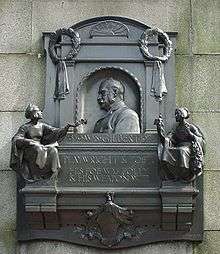George Frampton
_in_1915.jpg)

Sir George James Frampton, RA (18 June 1860 – 21 May 1928) was a notable British sculptor and leading member of the New Sculpture movement.[1]
Early life and career
He was born on 18 June 1860 in London to a stonemason. He began his working life in an architect's office before studying under William Silver Frith at the City and Guilds of London Art School (formerly Lambeth School of Art). He went on to the Royal Academy Schools where he won the Gold Medal and Travelling Scholarship. From 1887 to 1890 Frampton undertook further study and work at the studio of Antonin Mercie in Paris.[2]
Frampton returned to England and took up a teaching position at the Slade School of Art in 1893[3] By this time, Frampton was, according to the critic M.H. Spielmann "in open rebellion against white sculpture". In 1895 he showed Mother and Child at the Royal Academy, a polychromatic work, with the figures in bronze against a copper plaque, and a white disc behind the head. In his statue of Dame Alice Owen (1895) he combined bronze and marble, and in Lamia contrasted an ivory head and neck with bronze clothing. He made many busts and reliefs, mostly as memorials. His statues include a large bronze of Queen Victoria erected in Calcutta in 1901[4] and the Queen Victoria Statue in the grounds of the Manitoba Legislative Building in Winnipeg in 1904.[5]
Frampton's first house and studio was at 32 Queen's Grove (where a blue plaque to his name has been erected), but he later built a larger house nearby in Carlton Hill,[6] both in St John's Wood, London. He was married to the artist Christabel Cockerell and had one son, the painter and etcher Meredith Frampton.[2] He was an active member of The Art Workers' Guild and became Master in 1902. He sculpted the Art Workers' Guild's Master's Jewel in silver representing 'Art is Unity'
He died on 21 May 1928 and was cremated at Golders Green Crematorium on 25 May. His ashes lie in a niche on the ground floor of the east wing of the Ernest George Columbarium.
Best known works
Among Frampton's notable public sculptures are the figures of Peter Pan playing a set of pipes, the lions at the British Museum and the Edith Cavell Memorial that stands outside the National Portrait Gallery, London.[2] The original statue of Peter Pan in Kensington Gardens, London, was commissioned by J.M. Barrie in 1912. Six more casts were made of the statue, situated in:
- Perth, Western Australia, Australia
- Parc d'Egmont, Brussels, Belgium
- Bowring Park in St. John's, Newfoundland, Canada.
- Toronto, Canada
- Sefton Park, Liverpool, England
- Camden, New Jersey, United States
A number of his works can be seen at the restored St James' Church, Warter in Yorkshire.
After the death of Queen Victoria in early 1901, Frampton was chosen to create a bronze statue of the late queen in Calcutta, the capital of the British India. It was unveiled in March 1902, and was later placed outside the Victoria Memorial.
-
_by_WH_Latham.jpg)
George James Frampton (1860–1928)
-

St. Mungo as the Patron of Art and Music, Kelvingrove Art Gallery and Museum, Glasgow
-

Statue of Peter Pan in Bowring Park, St. John's, Newfoundland
References
- ↑ Read, Benedict (2 January 2005). "Subject in the New Sculpture". The Victorian Web. University of Leeds. Retrieved 26 October 2011.
- 1 2 3 "George Frampton". Oxford Dictionary of National Biography. Oxford: Oxford University Press. 2011. Retrieved 26 October 2011.
- ↑ "A Brief History of the Slade School of Fine Art". Retrieved 26 October 2011.
- ↑ Spielmann, M.H. (1901). British Sculpture and Sculptors of Today. London: Cassell. pp. 89–95.
- ↑ Baker, M. (1986). Symbol in Stone: The Art and Politics of a Public Building. Winnipeg: Hyperion Press, p. 119.
- ↑ "Sir George Frampton's new house in St. John's Wood". Victorianweb.org. 2010-12-22. Retrieved 2013-02-24.
See also
| Wikimedia Commons has media related to George Frampton. |
|